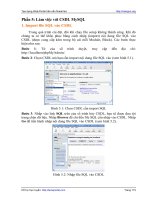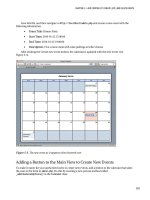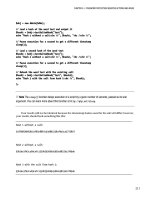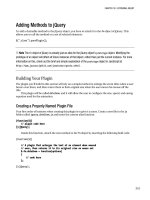Wordpress 3.0 jQuery - part 3 docx
Bạn đang xem bản rút gọn của tài liệu. Xem và tải ngay bản đầy đủ của tài liệu tại đây (1.66 MB, 10 trang )
Getting Started:
WordPress and jQuery
Welcome to WordPress and jQuery. The WordPress web-based publishing platform
and jQuery's JavaScript library are two of the most powerful tools used on the Web
today. Combining these tools together doubles the power and exibility of your
websites. Both technologies, being easy and fun to learn, create a recipe for web
magic. I hope you're ready for some fun and interesting insights by learning how
jQuery can improve your WordPress development experience.
In this chapter, we'll cover the following topics:
This book's approach and the core JavaScript language and WordPress skills
that you should understand in order to gain maximum advantage from it
The essential software tools that you'll need to get your project up
and running
The basic overviews of jQuery and WordPress
If anything in any of the following sections puzzles you, you may need a little
more background information and understanding before moving forward with
this title. No worries though, I'll point you towards some excellent sources for
more information.
•
•
•
Getting Started: WordPress and jQuery
[ 8 ]
This book's approach
This title introduces you to the essentials and best practices of using jQuery with
WordPress. It is not an introduction to programming with JavaScript and PHP,
nor is it a primer on using CSS with HTML mark-up. I'm assuming that you're a
WordPress site developer and/or a WordPress theme designer. Maybe you're just
someone who spends enough time managing and tinkering with a WordPress site
that you probably qualify as one of the above or both. Regardless of how you label
yourself, you use WordPress. WordPress helps you, or your clients, get content out
there quickly and simply, and you're always looking for ways to do more, faster,
and easily.
jQuery is a library that speeds the time and reduces the complications of writing
custom JavaScripts. I'm sure you must know that JavaScripts can be useful to a
website in a number of ways. They can also enable it with really cool-looking
features. While I'll be covering, in depth, as much on jQuery as possible, we won't
be looking at jQuery as the "big deal", JavaScript library entity that most other books
stress. Instead, we'll be considering jQuery a great tool that can help us get more
done, more easily (and yes, "with less" code) using WordPress.
To recap: So, you're a WordPress user, developer, or designer? Great. Let's look
at this "tool" called jQuery. It's going to make your WordPress development a lot
easier and probably look a lot better. Ready to get started?
Core fundamentals you need to know
As I mentioned, this book is geared toward WordPress users, visual theme
designers, and developers who are looking to learn to do more with WordPress by
using jQuery. I've tried to write this title so that client-side and server-side scripting
or programming experience isn't explicitly required. However, you'll see at the very
least that a general familiarity with the given subjects will help.
Regardless of your web development skill-set or level, you'll be walked through
with clear, step-by-step instructions. Let's go over the web development skills and
WordPress know-how that you'll need to be familiar with to gain the maximum
benet from this book. Again, I'll also point you to good resources if you feel you
need a little more background.
Chapter 1
[ 9 ]
WordPress
To start with, you should already be familiar with the most current, stable version
of WordPress. You should understand the basics of getting WordPress installed and
running on a web server or locally on your machine (especially as you'll need an
installation to tinker with the examples in this book). Not to worry, I'll point you in
the right direction for getting a basic local installation of WordPress on your Mac or
PC. Plus, many hosting providers offer easy one-click installs. You'll have to check
with your hosting provider to see if they offer WordPress. I'll also point you toward
a few other good resources for WordPress installations. Getting WordPress up and
running is often the easiest part of using WordPress.
Going a tad more in-depth, you'll do well to know your way around the WordPress
administration panel. You'll need to be familiar with adding content to the
WordPress publishing system and how posts, categories, static pages, and sub-pages
work. You'll also want to understand using the Media upload tools to add images
to posts and pages, as well as creating galleries. Lastly, understanding the basics of
installing and using different themes and plugins will also be helpful, though we
will cover this to some extent in this title.
Even if you'll be working with a more technical WordPress administrator, you
should have an overview of what the WordPress site that you're developing for
entails, and what (if any) themes or additional plugins or widgets will be needed
for the project. If your site does require a specic theme or additional plugins and
widgets, you'll want to have those installs handy and/or already installed in your
WordPress development installation (or sandbox—a place to test and play without
messing up a live site).
What version of WordPress does this book use?
This book focuses on the new features introduced in versions 2.8, 2.9, and
3.0 RC (Release Candidate—as of the writing of this book). Everything
covered in this book has been tested and checked in WordPress 2.9.2 and
3.0 RC. While this title's case studies are developed using version 2.9.2
and 3.0 RC, any newer version of WordPress should have the same core
capabilities, enabling you to enhance themes and plugins with jQuery for
it using these techniques. Bug xes and new features for each new version
of WordPress are documented at .
If you are completely new to WordPress, then I recommend you read
WordPress 2.7 Complete by April Hodge Silver and Hasin Hayder.
Getting Started: WordPress and jQuery
[ 10 ]
Basic programming
Having an understanding of programming in any client-side or server-side language
will help you out here, no matter what language—JavaScript, VBScript, .NET, ASP,
PHP, Python, Java, Ruby, you name it. If you're familiar working with, or at
the very least looking at, any of those languages, you'll do ne. Of course, the
following specic languages will really help.
JavaScript and AJAX techniques
OK, you denitely don't need to have any experience with AJAX whatsoever. But if
you know a bit about JavaScript (that's the "J" in "AJAX") you're off to a great start. In
particular, you should be able to understand how to recognize the overall syntax and
structure of JavaScript statements. For example: what variables look like in JavaScript
and how blocks for functions or conditions are set up using "
{ }" (curly brackets).
You'll also want to know how to properly end a line of JavaScript code with a ";"
(semicolon). Again, you don't need direct experience, but you should be comfortable
looking at a block of JavaScript code and understanding how it's set up.
For example, let's take a quick look at the following code example, which includes
explanatory comments:
<script type="text/javascript"> /*this is an XHTML script tag with the
type attribute set to define javascript*/
/*
This is a multi-line Comment.
You can use multi-line comments like this to add instructions or notes
about your code.
*/
//This is a single line comment for quick notes
function writeHelloWorld(){ /*this line sets up a function and starts
block of code*/
var text1 = "Hello"; //this is a variable called text1
document.write(text1); /*This writes "Hello" to the HTML body via
the variable "text1"*/
document.write(" World!"); /*Writes the string " World!" to the
HTML body. Note the ";" semi-colons ending each statement above, very
important!*/
}// this bracket ends the function block
writeHelloWorld(); /*evokes the function as a statement again, ending
with a ";" semi-colon.*/
//this closes the HTML script tag
</script>
Chapter 1
[ 11 ]
If you can follow what's happening in the given code snippet, and you're condent
that you could alter, say, the variable without breaking the script, or change the
name of the function and where it's evoked, you're doing well enough for this title.
Of course, the more you know about working with different types of information
such as strings, integers, and arrays as well as loops and if/else statements, the
better. But again, just understanding the general syntax for now, will certainly
get you started with jQuery and this title.
AJAX is not really a language. As we'll learn in Chapter 7, AJAX with jQuery and
WordPress, it's simply a set of techniques for working with Asynchronous JavaScript
and XML, using JavaScript and HTTP requests together to develop highly dynamic
pages. Developers like this approach as it allows them to create pages that respond
more like desktop programs, than standard web pages. If you're interested in using
AJAX with WordPress, in Chapter 7, AJAX with jQuery and WordPress, we'll get
into how jQuery can help you with various AJAX techniques. But it's by no means
essential for taking advantage of jQuery with WordPress.
If you're new to JavaScript and want a quick, fun primer, I highly
recommend the W3Schools' site. This site is a great resource
for priming yourself with all W3C compliant web technology.
You can nd out about AJAX
too: />PHP
You denitely don't have to be a PHP programmer to get through this book,
but PHP is what WordPress is built with and its themes use liberal doses of PHP
to work their magic! WordPress plugins are almost pure PHP. Any hope of adding
jQuery functionality to a WordPress theme or plugin will require braving a little
PHP syntax.
As with JavaScript, if you at least understand how basic PHP syntax is structured,
you'll be much less likely to make mistakes while retyping or copying and pasting
code snippets of PHP and WordPress template tags, in your theme's template les.
Getting Started: WordPress and jQuery
[ 12 ]
The good news is PHP syntax is structured similarly to JavaScript syntax. PHP also
uses curly brackets in the same way to denote blocks of code for functions, loops,
and other conditions. You also end every statement in PHP with a semicolon just
as you would in JavaScript. The main difference is that PHP is evoked by wrapping
code snippets inside
<?php ?> tags, which are not part of the XHTML tag set and
JavaScript is evoked by placing code snippets inside the XHTML <script> tags.
Also, variables in PHP are denoted with a "
$" (dollar) sign, permanently prepended
to the variable name you create, rather than established once with the
var statement.
The biggest difference is that PHP is a server-side scripting language and JavaScript
is client-side. That means that JavaScript downloads and runs inside the user's
browser on their machine, while PHP code is pre-interpreted on the web server and
only the nal, resulting XHTML (and sometimes CSS and JavaScript—you can do a
lot with PHP!) is served up into the user's web browser.
Let's take a quick look at some basic PHP syntax:
<?php /*All PHP is evoked using greater-than brackets and a "?"
question mark, followed by the letters "php"*/
//This is a single-line comment
/*
This is multi-line
comment block
*/
function newHelloWorld(){/*this sets up a function and code block*/
$text1 = "Hello"; //creates a variable called: $text1
echo $text1." World!"; /*tells the HTML page to print , aka:
"echo" the variable $text1 with the string " World!" concatenated onto
it.*/
}//this ends the code block
newHelloWorld(); //calls the function as a statement ending with a
semi-colon.
//the question mark and closing less-than tag end the PHP code.
?>
I'm sure you recognize some differences between PHP and JavaScript right away, but
there are also quite a few similarities. Again, if you're condent that you could swap
out a variable value without breaking the function, you'll do ne with WordPress
and this title. As always, the more you know about PHP the better.
Chapter 1
[ 13 ]
Do I have to add "php" to my <? starter block?
You'll notice I've set up my PHP starter block as: "<?php". Those of you
with some PHP knowledge or having some WordPress experience, may
be familiar with PHP blocks that just start with <? and end with ?>.
On servers with
shorthand support enabled, you can start a scripting
block with just "<?" (as well as use a few other cool PHP shorthand
tricks).
However, while shorthand support is usually enabled, not everyone's
PHP installation will have it enabled. When I have clients or friends
who can't seem to get a new plugin or theme to work with their
WordPress installation, this often comes up as the culprit. The theme
or plugin was written using shorthand and the client's PHP installation
doesn't have it enabled and for some reason, their IT guy or hosting
provider doesn't want to enable it. To stay as compatible as possible,
we'll be using the standard form in this book (<?php) rather than the
shorthand form.
If you'd like to understand WordPress a little better by knowing
more about PHP, again, that W3School site is a great place to start!
( />After reading this book, if you nd PHP really interests you as well as
JavaScript, AJAX, and jQuery, you might want to move onto reading
AJAX and PHP: Building Modern Web Applications 2nd Edition by
Audra Hendrix, Bogdan Brinzarea, and Cristian Darie.
More of a visual "see it to do it" learner? lynda.com has a remarkable
course selection from the top CSS, XHTML/XML, PHP, JavaScript
(and yes, even jQuery) people in the world. You can subscribe and
take the courses online or purchase DVD-ROMs for ofine viewing.
The courses or the monthly subscription might seem pricey at rst,
but if you're a visual learner, it's worth spending money and time on
them. You can refer to the ofcial site at .
Essential tools
Skills are one thing, but the better your tools are, and the more command you
have over those tools, the better your skills can be put to use (you can just ask any
carpenter, golfer, or app programmer about the sheer importance of the "tools of
the trade").
Getting Started: WordPress and jQuery
[ 14 ]
Code/HTML editor
First up, we'll need to meddle with markup and code—lots of markup, CSS, PHP,
and jQuery. So, you'll need a good code or HTML editor. Dreamweaver is a great
option (
although I prefer to use
Coda for Mac ( Before I discovered working with
Coda, I was very happy with the free editor TextWrangler (ebones.
com/products/textwrangler/
). When I was working on a PC, I loved the free text/
code editor HTML-kit (
/>There are thousands of editors out there, some free, some expensive, and with
varying degrees of features. Just about every developer and designer I've talked to,
uses something different and has a ten-minute "schpiel" about why their editor is the
best. Ultimately, any HTML or text editor that lets you enable the following features
will work just great. I recommend you enable/use all of the following:
View line numbers: This comes in very handy during the validation and
debugging process. It can help you nd specic lines in a jQuery script,
theme, or plugin le, for which a validation tool has returned a x. This is
also helpful for other theme or plugin instructions given by their author,
which refer to a specic line of code that might need customizing or editing
under different conditions.
View syntax colors: Any worthwhile code and HTML editor has this feature
usually set as a default. The good editors let you choose your own colors.
This displays code and other markup in a variety of colors, making it easier
to distinguish various types of syntax. Many editors also help you identify
broken XHTML markup, CSS rules, or PHP code.
View non-printing characters: You might not want this feature turned on
all the time. It makes it possible to see hard returns, spaces, tabs, and other
special characters that you may or may not want in your markup and code.
Text wrapping: This of course lets you wrap text within the window, so you
won't have to scroll horizontally to edit a long line of code. It's best to learn
what the key-command shortcut is for this feature in your editor, and/or
set up a key-command shortcut for it. You'll nd it easier to scroll through
unwrapped, nicely-indented, markup and PHP code to quickly get a general
overview or nd your last stopping point; however, you will still want to
turn wrapping on quickly so you can easily see and focus your attention on
one long line of code.
•
•
•
•
Chapter 1
[ 15 ]
Load les with FTP or local directories: An editor that allows you to connect
through FTP or see your local working directory in a side panel, is extremely
helpful. It saves you from having to manually nd les locally in your OS
explorer or nder, or from having to upload through an additional FTP
client. Being able to connect to your les in a single application just speeds
up your workow.
Free open source HTML editors:
I've also used Nvu ( and KompoZer
( They're both free, open source, and
available for Mac, PC, and Linux platforms. KompoZer was made from
the same source as Nvu and, apparently, xes some issues that Nvu has.
(I haven't run into any major issue with Nvu myself). Both editors are
too limited for my regular use, but I do like being able to format HTML
text quickly and drag-and-drop form objects onto a page. Both editors
have a Source view, but you must be careful while switching between
the Normal and the Source view tabs. Nvu and KompoZer are a little too
helpful, and will try to rewrite your handcoded markup if you haven't set
your preferences properly!
Linux users of Ubuntu and Debian (and Mac users with Fink) might also
be interested in checking out the Bluesh editor (http://bluefish.
openoffice.nl). I use Bluesh when working on Ubuntu Linux.
I prefer it when on Linux, though it's robust enough to probably be
considered more of an IDE (Integrated Development Environment),
similar to Eclipse (), rather than just a basic
code or HTML editor. Many of you may nd that a tool like Bluesh
or Eclipse is overkill for your general WordPress development and
maintenance needs. On the other hand, if you're serious about WordPress
development, they may have features you nd invaluable and they are
worth downloading and checking out.
•









